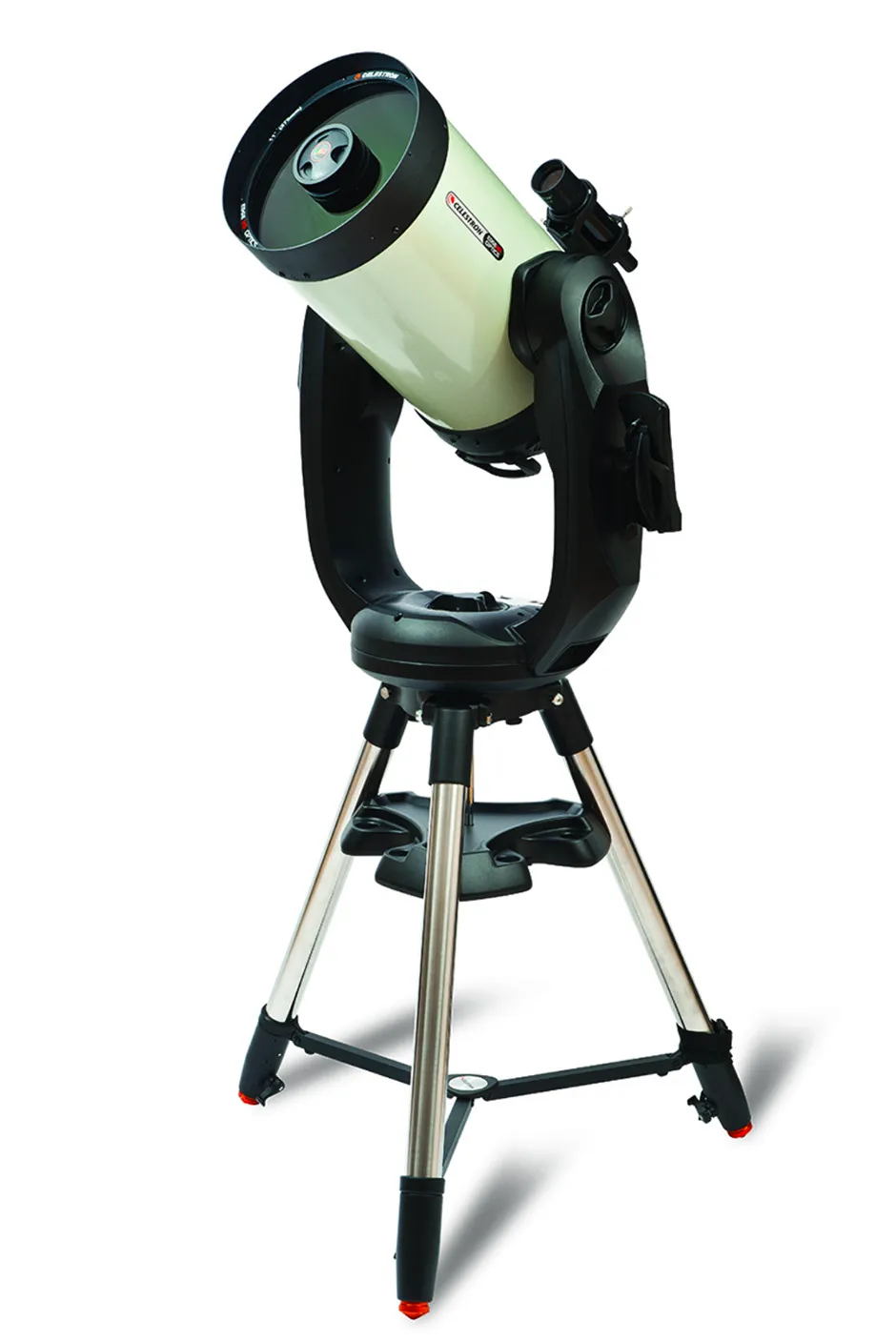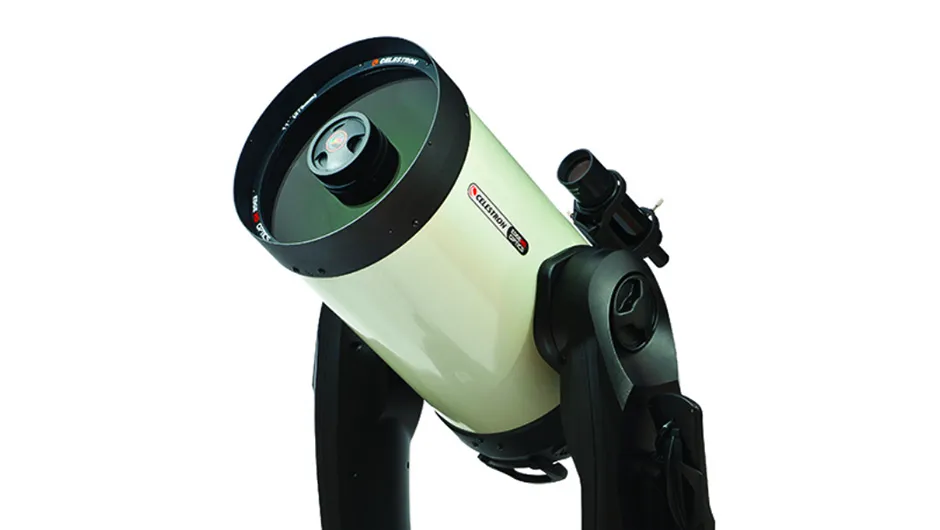It’s hard to say what the perfect size and type of telescope is.
Light grasp is really important, but the qualities needed to study the Moon and planets in detail often conflict with those necessary for deep-sky viewing.
Deep-sky objects are typically faint, so ‘light-bucket’ scopes like Dobsonians with a low-power eyepiece tend to give the best views.
The brighter planets and the Moon offer plenty of light, so the emphasis here tends to be about getting sufficient magnification to be able to see intricate surface detail.
The new CPC Deluxe 1100 HD from Celestron is a good scope for both.
Its generous 11 inches of aperture gathers plenty of light from nebulae and galaxies, while its focal length is long enough to get really detailed views of bright Solar System objects with a modest set of eyepieces.
The optical tube is permanently held between two solid arms, joined at the base by a housing that contains the scope’s drives and Go-To computer.
There are two handles provided to help you lift the assembly onto its tripod, but it is heavy so this is a job better suited to two people.
Once mounted, setting it up is fairly straightforward.
The mount is altazimuth and its onboard computer tracks the stars’ apparent movement.
Built-in sensors tell the mount whenand where it is in the world – all you need to do is calibrate the pointing accuracy by centring up alignment stars using a choice of programmed routines.
This telescope features in our guide to the best telescopes for observing planets

These are pretty easy to use – the SkyAlign option doesn’t even require you to know what you’re pointing at!
The Go-To pointing accuracy was excellent, placing all the objects requested in the field of view and holding them in position throughout the viewing session.
The scope uses Celestron’s latest EdgeHD opticsto provide an impressively flat field with pinpoint stars right to the edge of view.
Visually, the instrument is a real treat – the views show high contrast and have a real vibrancy about them.
Looking at the Orion Nebula was mesmerising, with the stars of the Trapezium Cluster shining intensely.
A sharp tendril of nebulosity known as the ‘Sword’ seemed to go on forever.
Slightly to the north,NGC 1977, the Running Man Nebula, glowed against the inky black sky backdrop.
The large image scale is ideal for smaller objects: a view of the planetary nebula NGC 2392, the Eskimo Nebula, easily revealed a brighter inner disc surrounded by a more nebulous outer ring.
Closer to home, Jupiter looked like an etching using the supplied 23mm eyepiece: a sharp discwith a clear view of the two main belts exquisitely intertwined with fine intricate detail.
You could spend hours watching the planet with this quality of view.
Closer still, the Moon appeared crisp and vibrant, with lots of fine detail.
A good all-rounder
Focusing is smooth and responsive, and the 2-inch, 23mm eyepiece that is supplied with the telescope does work well, despite showing colour fringing on bright objects.
Two mirror locks are also provided, to hold the primary mirror securely in place during long-exposure imaging.
Unfortunately, the altaz mount supplied isn’t best suited for long exposures because it introduces field rotation.
Over time, this effect causes stars to trail as arcs centred on the field of view.

This issue canbe overcome by fitting an equatorial wedge (around £350) or a camera rotator (around £400).
Although still affected by field rotation, the shorter exposures required for Solar System imaging do permit you to get high-quality shots of the brighter planets and the Moon by using a suitable high frame-rate camera.
In summary, there’s a lot to like about this scope.
It has a huge light grasp for deep-sky objects andits long focal length is ideal for Solar System viewing.
It’s easy to set up and operate, and the built-in Go-To is reassuringly accurate.
It’s a bit cumbersome to manipulate onto its tripod, but once you’re there, a spectacular view of the Universe is quite literallyat your fingertips.
HD-ready for vibrant views
Celestron’s new EdgeHD optics really do deliver an impressive field of view.
Described as an aplanatic-Schmidt design, the claim is that the optics deliver an aberration-free, flat field across the entire field of view, something that can be appreciated both visually and photographically.
Through the eyepiece, there’s nothing to dispute this.
The view is very clean indeed and objects seem to have a definite vibrancy about them.
Part of this is also down to Celestron’s use of Starbright XLT coatingson the optical surfaces.
This advanced coating helps minimise the loss of light due to internal reflections and maximises transmission.
Distortion-free optics combined with Starbright XLT coatings resultin brilliant stars that really seem to blaze against the dark sky.
This follows through to the faint fuzzies as well.
Galaxies and nebulae have a beautifully subtle glow to them – Messier 78 inOrion looked like a mist with two bright stars embedded within,staring back like a pair of cosmic eyes.
These optics really deliver impressive and exciting views.
Optics
The EdgeHD optics don’t disappoint: the 11-inch aperture delivers bright, high-contrast views, with pin-point stars right to the edge of the field of view.
With a focal length of 2.8m, even a low-power eyepiece like the 23mm one supplied gets you right into the action.
Fork mount
The telescope and its fork mount weigh 30kg.
Placed on the sturdy tripod, the whole arrangement feels very solid and rigid.
To assist in lifting the scope and fork assembly onto the tripod, two carry handles are provided – one at the base of the tube and one on the forks.
Drive system
The NexStar computer control system is located in the base of the fork assembly.
Although this is an altaz mount, the computer controls the built-in drives so that the scope follows the natural motion of the stars.
Despite being in constant movement the drives remain remarkably quiet when in operation.
Diagonal and eyepiece
The supplied 2-inch diagonal screws into the rear of the main tube to provide a more convenient viewing angle.
The 23mm, 2-inch Axiom LX eyepiece complements the scope package well.
The views through it are crisp and vibrant, and with an 82º field you almost feel you can float into the view.
Go-To computer
There’s a database of 40,000 objects for you to pick from.
This includes deep-sky delights from the Messier and NGC catalogues, and more.
There are numerous connections available on the fork base, and the scope can be operated from a PC using the supplied RS-232 connection cable.
Vital stats
- Price £4999.00
- Aperture 280mm (11 inches)
- Focal Length 2800mm (f/10)
- Eyepieces 23mm, 82º Axiom LX, 2-inch fit
- Finderscope 50mm with quick release bracket
- Mount Dual-arm fork; heavy duty stainless steel tripod
- Weight 30kg
- Supplier David Hinds Ltd.
- Telephone 01525 852696
- Website:www.celestron.uk.com
This review was first published in the March 2012 issue of Sky at Night Magazine. Prices correct at the time of going to press.
